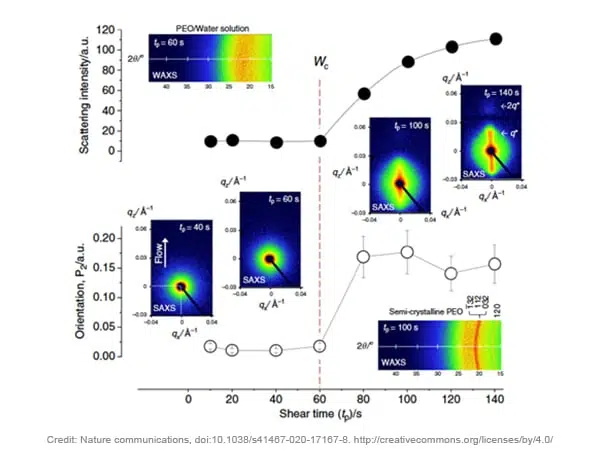Spider silk has been a thankful subject for biomimetic research over the course of many years. It is well-known for its incredible tensile strength and biocompatibility. Consequently, there are countless examples of artificial mimics based on a range of materials. Less well studied but equally interesting is the mechanism of formation of silk fibers. Spider silk is formed into solid fibers by the shear force of the silk ducts on the liquid silk stored in the spider’s body. These shear forces initiate the formation of crystal nuclei on which the material further crystallizes. Interestingly, the corresponding synthetic process requires a much higher activation energy than that of the formation of silk. G.J. Dunderdale et al. from the University of Sheffield have now successfully developed an energy efficient procedure to induce crystallization of an aqueous poly(ethylene oxide) (PEO) solution by eliciting shear force.[1]

Formation of crystallites is achieved by heating the solutions to achieve a homogeneous sample, followed by cooling and shearing the solution to deliver the critical specific work (Wc). In situ Small and Wide-Angle X-ray Scattering (SAXS and WAXS) patterns, collected while the solution is being sheared using a Linkam CSS 450 shear cell, clearly show the onset of crystallization. This is reflected by the steady increase of the scattering intensity as well as the orientation of the sample indicated by the rise of Herman’s orientation function P2 (see the image above with 2D SAXS pattern and evolution of extracted parameters). The 2D WAXS pattern collected simultaneously also clearly shows the reflections characteristic for the formation of a PEO 72 helical structure.
These results are in close agreement with shear-induced polarized light imaging (SIPLI), where the onset of crystallization is indicated by the formation of a Maltese Cross pattern. With this combination of techniques, the researchers have clearly demonstrated the ability to mimic the phase transition of an aqueous polymer solution to a solid material upon shearing.
































